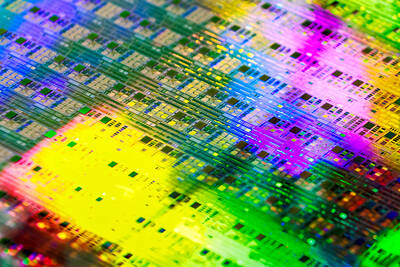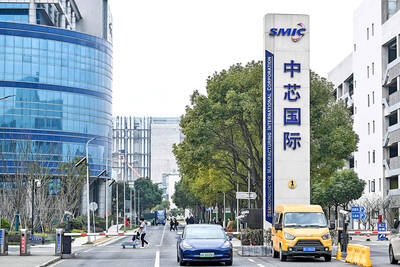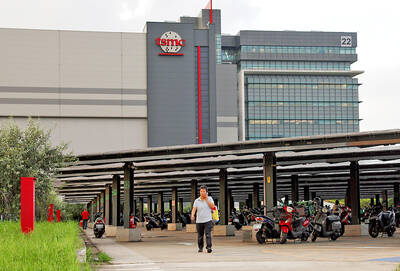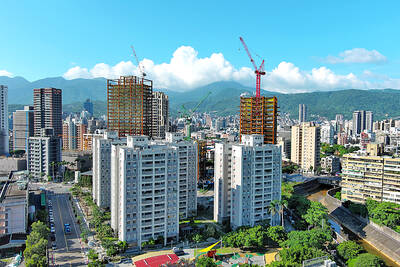AU Optronics Corp (友達光電), the world's third-largest maker of liquid-crystal-display panels, yesterday said it signed an agreement with Korean rival Samsung Electronics Co to share patents for flat-panel manufacturing technologies in a bid to strengthen competitiveness.
Under the agreement, the two companies would share licenses including patents in the area of thin-film-transistor-liquid-crystal-displays (TFT-LCD) and organic light-emitting diodes (OLED), especially concerning the technology for LCD TV applications, AU Optronics said in a statement released yesterday.
"AU Optronics and Samsung expect the agreement to bolster the development and deployment of TFT-LCD technology in LCD TVs, providing a new catalyst to strengthen the competitiveness of both companies," they said in the statement.
AU Optronics declined to reveal the value of the transaction and the number of patents involved. The deal takes effect immediately.
TFT-LCD technology is now the most widely used technology among a wide range of flat panel manufacturing technologies for consumer electronics, while OLED technology is mostly used in making smaller-sized screens, such as 2 inch ones, panels for mobile phones and digital music players.
Samsung is the world's biggest OLED panel maker with 26.4 percent market share in terms of shipments as of the third quarter of last year, according to market researcher DisplaySearch. The company is also the world's No.2 maker of TFT-LCD panels.
AU Optronics postponed the mass production of its own OLED panels for mobile phones to the first quarter, according to the research house.
"It is rare for OLED panel makers to share patents. The patent sharing agreement is quite a positive sign for the industry," said DisplaySearch analyst Jane Hsu (徐玉娟).
As OLED panel makers made much greater efforts than TFT-LCD makers in building up intellectual property rights, it would not be easy for manufacturers to avoid patent infringement, Hsu said.
AU Optronics said it now owns over 1,700 patents worldwide, with over 3,300 patents pending.
To extend its patent coverage, AU Optronics purchased 170 patents related to TFT-LCD manufacturing technology from International Business Machines Corp of the US last year.
The company is not alone in moving to strengthen its intellectual property position amid strong competition. Rival Chi Mei Optoelectronics Corp (奇美電子) also said it signed contracts with Japan's Hitachi Display Ltd on cross-authorization of some 1,000 LCD patents in June.

NO BREAKTHROUGH? More substantial ‘deliverables,’ such as tariff reductions, would likely be saved for a meeting between Trump and Xi later this year, a trade expert said China launched two probes targeting the US semiconductor sector on Saturday ahead of talks between the two nations in Spain this week on trade, national security and the ownership of social media platform TikTok. China’s Ministry of Commerce announced an anti-dumping investigation into certain analog integrated circuits (ICs) imported from the US. The investigation is to target some commodity interface ICs and gate driver ICs, which are commonly made by US companies such as Texas Instruments Inc and ON Semiconductor Corp. The ministry also announced an anti-discrimination probe into US measures against China’s chip sector. US measures such as export curbs and tariffs

The US on Friday penalized two Chinese firms that acquired US chipmaking equipment for China’s top chipmaker, Semiconductor Manufacturing International Corp (SMIC, 中芯國際), including them among 32 entities that were added to the US Department of Commerce’s restricted trade list, a US government posting showed. Twenty-three of the 32 are in China. GMC Semiconductor Technology (Wuxi) Co (吉姆西半導體科技) and Jicun Semiconductor Technology (Shanghai) Co (吉存半導體科技) were placed on the list, formally known as the Entity List, for acquiring equipment for SMIC Northern Integrated Circuit Manufacturing (Beijing) Corp (中芯北方積體電路) and Semiconductor Manufacturing International (Beijing) Corp (中芯北京), the US Federal Register posting said. The

READY TO HELP: Should TSMC require assistance, the government would fully cooperate in helping to speed up the establishment of the Chiayi plant, an official said Taiwan Semiconductor Manufacturing Co (TSMC, 台積電) yesterday said its investment plans in Taiwan are “unchanged” amid speculation that the chipmaker might have suspended construction work on its second chip packaging plant in Chiayi County and plans to move equipment arranged for the plant to the US. The Chinese-language Economic Daily News reported earlier yesterday that TSMC had halted the construction of the chip packaging plant, which was scheduled to be completed next year and begin mass production in 2028. TSMC did not directly address whether construction of the plant had halted, but said its investment plans in Taiwan remain “unchanged.” The chipmaker started

MORTGAGE WORRIES: About 34% of respondents to a survey said they would approach multiple lenders to pay for a home, while 29.2% said they would ask family for help New housing projects in Taiwan’s six special municipalities, as well as Hsinchu city and county, are projected to total NT$710.65 billion (US$23.61 billion) in the upcoming fall sales season, a record 30 percent decrease from a year earlier, as tighter mortgage rules prompt developers to pull back, property listing platform 591.com (591新建案) said yesterday. The number of projects has also fallen to 312, a more than 20 percent decrease year-on-year, underscoring weakening sentiment and momentum amid lingering policy and financing headwinds. New Taipei City and Taoyuan bucked the downturn in project value, while Taipei, Hsinchu city and county, Taichung, Tainan and Kaohsiung